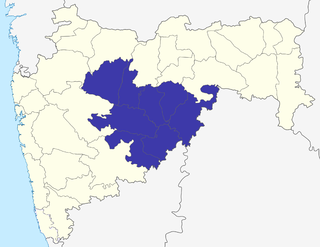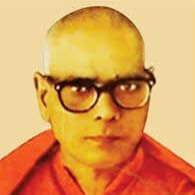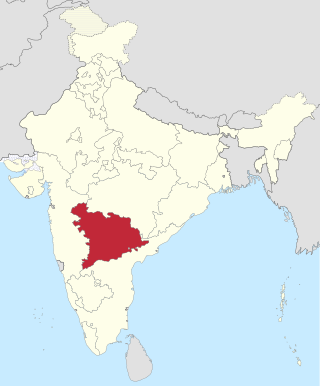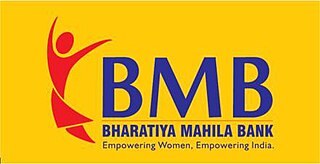
Hyderabad State was a princely state in the Deccan region of south-central India with its capital at the city of Hyderabad. It is now divided into the present-day state of Telangana, the Kalyana-Karnataka region of Karnataka, and the Marathwada region of Maharashtra in India.

State Bank of India (SBI) is an Indian multinational public sector bank and financial services statutory body headquartered in Mumbai, Maharashtra. It is the 48th largest bank in the world by total assets and ranked 178th in the Fortune Global 500 list of the world's biggest corporations of 2024, being the only Indian bank on the list. It is a public sector bank and the largest bank in India with a 23% market share by assets and a 25% share of the total loan and deposits market. It is also the tenth largest employer in India with nearly 250,000 employees. In 2024, the company’s seat in Forbes Global 2000 was 55.

Marathwada is a proposed state and geographical region of the Indian state of Maharashtra. It was formed during the Nizam's rule and was part of the then Hyderabad State. The region coincides with the Aurangabad division of Maharashtra. It borders the states of Karnataka and Telangana, and it lies to the west of the Vidarbha and east of Uttar Maharashtra regions of Maharashtra. The largest city of Marathwada is Aurangabad. Its people speak Marathi and Deccani Urdu.
Raj Bhavan is the official residence of the governor of Telangana located in the city of Hyderabad, India. It is located at Somajiguda adjacent to Hussain Sagar lake.

Nanded is a city in Maharashtra state, India. It is the tenth largest city in the state and the seventy-ninth most populated city in India. It is the second largest city in Marathwada region. It is the district headquarters of Nanded district.
State Bank of Travancore (SBT) was a major Indian bank headquartered in Thiruvananthapuram, Kerala, and was a major associate of State Bank of India.

Modern banking in India originated in the mid of 18th century. Among the first banks were the Bank of Hindustan, which was established in 1770 and liquidated in 1829–32; and the General Bank of India, established in 1786 but failed in 1791.

Osmanabad District, officially known as Dharashiv District, is an administrative district in the Marathwada region in the Indian state of Maharashtra. The district headquarter is located at Osmanabad. The District of Osmanabad derives its name from the last ruler of Hyderabad, the 7th Nizam, Mir Osman Ali Khan, of which the region was a part till 1947. This region was earlier part of The Hyderabad State until Independence.This primarily rural district occupies an area of 7,569 km2 (2,922 sq mi) of which 241.4 km2 (93.2 sq mi) is urban and has a population of 1,657,576 of which 16.96% were urban.

Osman Sagar is a reservoir in the Indian city of Hyderabad. The lake is around 46 km2, and the reservoir is around 29 km2, with total level of 1,790 feet and a capacity of 3.9 tmc ft.

Mir Osman Ali Khan, Asaf Jah VII was the last Nizam (ruler) of Hyderabad State, the largest state in the erstwhile Indian Empire. He ascended the throne on 29 August 1911, at the age of 25 and ruled the State of Hyderabad between 1911 and 1948, until the Indian Union annexed it. He was styled as His Exalted Highness (H.E.H) the Nizam of Hyderabad, and was widely considered one of the world's wealthiest people of all time. With some estimates placing his wealth at 2% of U.S. GDP, his portrait was on the cover of Time magazine in 1937. As a semi-autonomous monarch, he had his mint, printing his currency, the Hyderabadi rupee, and had a private treasury that was said to contain £100 million in gold and silver bullion, and a further £400 million of jewels. The major source of his wealth was the Golconda mines, the only supplier of diamonds in the world at that time. Among them was the Jacob Diamond, valued at some £50 million, and used by the Nizam as a paperweight.

State Bank of Patiala, founded in 1917, was an associate bank of the State Bank Group. It merged with State Bank of India on 1 April 2017. At the time of its merger, State Bank of Patiala had a network of 1445 service outlets, including 1314 branches, in all major cities of India, but most of the branches were located in the Indian states of Punjab, Haryana, Himachal Pradesh, Rajasthan, Jammu & Kashmir, Uttar Pradesh, Madhya Pradesh, Delhi, Gujarat and Maharashtra.

The Telangana High Court is the High Court for the Indian state of Telangana. Founded by the 7th Nizam of Hyderabad Mir Osman Ali Khan, initially, it was set up as High Court of Hyderabad for the then princely state of Hyderabad Deccan and later renamed High Court of Andhra Pradesh, as it was set up on 5 November 1956 under the States Reorganisation Act, 1956. The Andhra Pradesh High Court was renamed as High Court of Judicature at Hyderabad in view of the bifurcation of Andhra Pradesh state.

Canara Bank is an Indian public sector bank based in Bangalore, India. Established in 1906 at Mangalore by Ammembal Subba Rao Pai. The bank was nationalized in 1969. Canara Bank also has offices in London, Dubai and New York.

Swami Ramanand Tirtha was an Indian politician, freedom fighter, educator and social activist who led the Hyderabad liberation struggle during the reign of Osman Ali Khan, the last Nizam of Hyderabad State. Swami Ramanand Tirtha was the principal leader of the Hyderabad State Congress. Before taking Sanyasa, his family name was Vyenkatesh Bhagvanrao Khedgikar.

Regional rural banks (RRBs) are government owned scheduled commercial banks of India that operate at the regional level in different states of India. These banks are under the ownership of the Ministry of Finance, Government of India, Sponsored Bank and concerned State Government in the ratio of 50:35:15 respectively. They were created to serve rural areas with basic banking and financial services. However, RRBs also have urban branches.
Public Sector Undertakings (Banks) are a major type of government-owned banks in India, where a majority stake (i.e., more than 50%) is held by the Ministry of Finance (India) of the Government of India or State Ministry of Finance of various State Governments of India. The shares of these government-owned-banks are listed on stock exchanges. Their main objective is social welfare.

Hyderabad State was a state in Dominion and later Republic of India, formed after the accession of the State of Hyderabad into the Union on 17 September 1948. It existed from 1948 to 1956. Hyderabad State comprised present day Telangana, Marathwada and Hyderabad-Karnataka

Bharatiya Mahila Bank was a fully owned subsidiary of State Bank of India based in Mumbai, India. Former Indian Prime Minister Manmohan Singh inaugurated the system on 19 November 2013 on the occasion of the 96th birth anniversary of former Indian Prime Minister Indira Gandhi. As part of the Modi government's banking reforms and to ensure greater banking outreach to women, the bank merged with State Bank of India on 1 April 2017.

The history of Telangana, located on the high Deccan Plateau, includes its being ruled by the Satavahana Dynasty, the Kakatiya Dynasty (1083–1323), the Musunuri Nayaks (1326–1356), the Delhi Sultanate, the Bahmani Sultanate (1347–1512), Golconda Sultanate (1512–1687) and Asaf Jahi dynasty (1724–1950).

Lady Hydari Club was an elite club exclusive to women in the erstwhile Hyderabad state in India. It was located in what is now the Old Gandhi Medical College near Basheerbagh.























